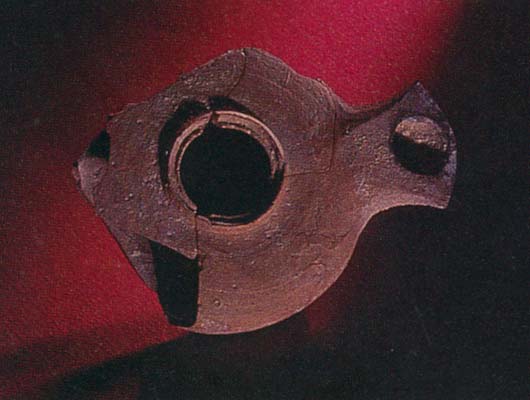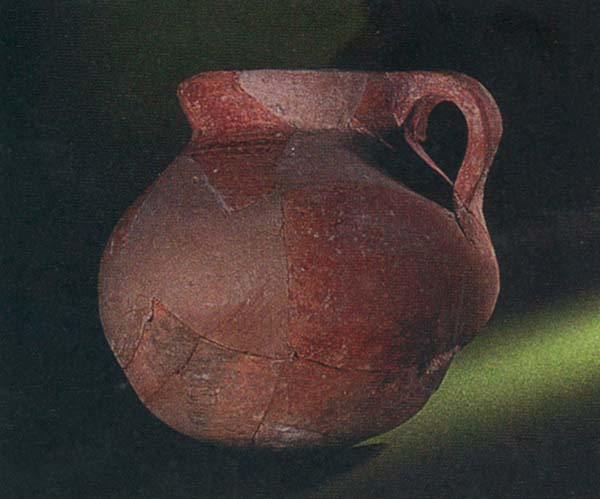Burial Cave of the Caiaphas Family

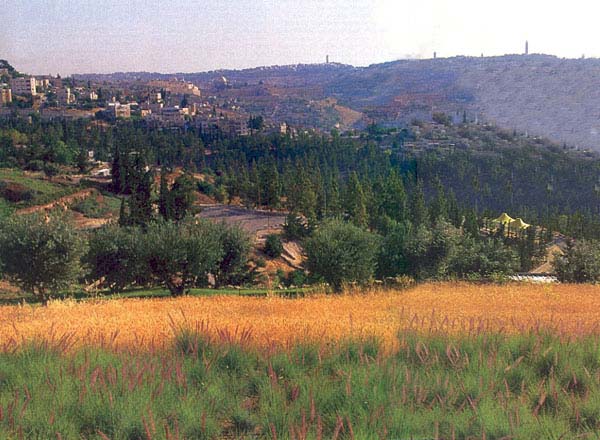
The history of archaeology is filled with accidental discoveries. With all our scientific tools and methodologies, chance continues to be a major component of our success. So it was that we discovered the final resting place of the Caiaphas family, one of whose priestly members presided at the trial of Jesus. Whether we have also recovered the burial box and even the bones of the high priest Caiaphas who handed Jesus over to the Romans is another question.
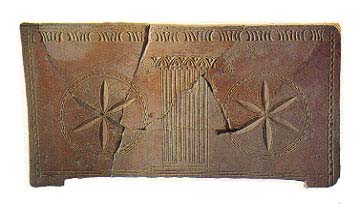
In a sense, everything can be traced to the Haas family, who funded what we call in Hebrew a tayelet (ta-YEL-et), literally a “promenade,” a beautiful stone walkway on a ridge on the outskirts of Jerusalem. The Haas Tayelet wends its way for half a mile south of Mt. Zion, not far from Government House where the United Nations was headquartered before the state of Israel was established (the hill where Government House was built is identified traditionally with the Hill of Evil Counsel).
The Haas Tayelet, created in 1987, commands a magnificent view of the Judean desert, the Old City of Jerusalem and the colorful neighborhood of Abu Tor where both Jews and Arabs live. Between the promenade and Abu Tor, just below the promenade is a green area known as the Peace Forest. Here the Jerusalem Foundation decided to create a kind of water park for the diversion of the Jerusalemites (and tourists) who flock to the Haas promenade. And it was here that one of the most spectacular archaeological finds in recent years was made.
It was a cold day at the end of November 1990 when I received word at the Antiquities Authority offices that an old cave had been discovered in the Peace Forest during the creation of the water park by the Jerusalem Foundation.
This was hardly surprising. There are numerous archaeological remains in this area. The lower water aqueduct that carried water in Herodian times (37 B.C.E.–70 C.E.a) from the misnamed Pools of Solomon, south of Bethlehem, to the Temple Mountb passes through the Peace Forest. In the valley below the Peace Forest is the Nahalc Etzel (Wadi Yatzal in Arabic), which drains into the Kidron Valley. The slope of the valley leading up to the tayelet is part of a huge necropolis dating to the late Second Temple period (first century B.C.E.-first century C.E.).1 So it was not unusual that work for the park in the Peace Forest uncovered a burial cave.
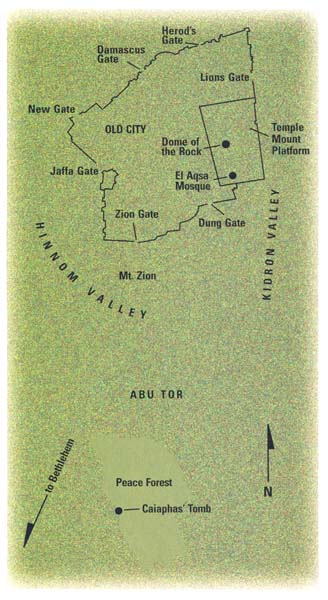
Nevertheless, I immediately went to the site. When I arrived, I observed that the roof of the cave had collapsed. But even while standing outside, I could see four ossuaries, or bone boxes, in the central chamber of the cave. To an archaeologist, this was a clear indication that this was a Jewish burial cave from the Second Temple period, because ossuaries were used only in Jewish tombs during this period. Ossuaries were used for what is known as secondary burial. In the initial or primary burial, the body was laid out in a niche or recess carved in the wall of the burial cave. Then, after the flesh had decomposed, the bones were collected and placed in an ossuary, usually made of limestone and often decorated and inscribed. The ossuaries were usually placed in a niche in the cave. It seems that the reburial reflects a belief in the physical resurrection of the body for which purpose the bones were collected and preserved.2 Reburial in ossuaries appears mainly at the end of the first century B.C.E. and in the first century C.E. Reburial in an ossuary was rare in Jewish tombs after the Roman destruction of Jerusalem in 70 C.E.
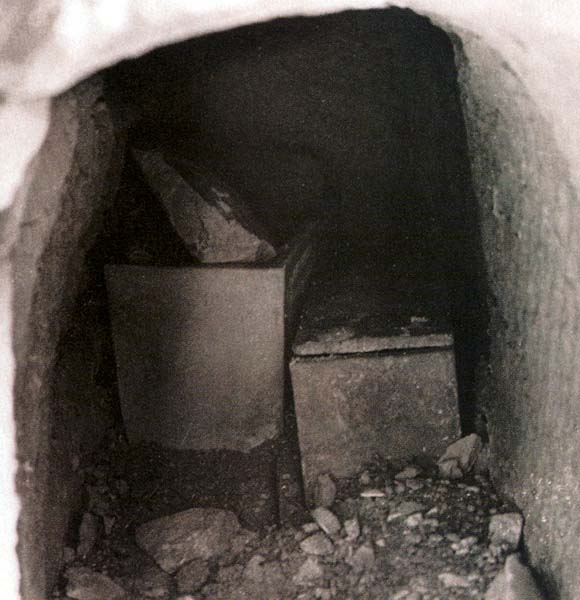
Once we got inside the cave through the hole in the roof, we observed from the architecture another clear indication that this was a Jewish burial cave. Inside we found four typical niches, or recesses, carved in the rock walls. Called loculi (kokhim in Hebrew; singular, kokh), they are rectangular spaces, about 6 feet deep into the rock and 1.5 feet wide, often with a slightly arched top. There were three loculi in the west wall of this cave and one loculus in the south wall. In the latter were two more ossuaries. Unlike the four ossuaries in the center of the cave, these two ossuaries were in situ, lying side by side in the loculus.
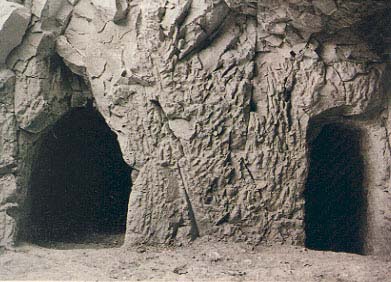

The cave itself was carved into the soft limestone bedrock characteristic of the eastern slopes of the Judean desert. It is crumbly, and the walls of the cave were full of cracks.
It was obvious that an immediate rescue excavation was required. We assembled equipment and in three days had excavated the site.d
In addition to the six ossuaries I have already mentioned, we found the remains of another six ossuaries (a total of twelve), but the second six were found turned over without covers, scattered about, and sometimes broken. This indicated that the cave had been robbed in ancient times, but apparently these tomb robbers never completed their work. The four ossuaries we observed in the center of the floor when we first arrived had been removed from their loculi by modern workmen before we got to the site, as I was later told by the contractor. Thus, a total of six ossuaries were in situ when discovered. The other six had been ransacked by ancient tomb robbers.
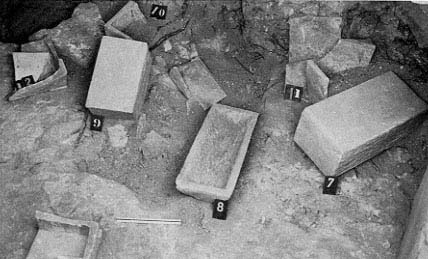
Our excavation easily revealed the floor plan of the cave. A rectangular pit had been dug inside the entrance, which allowed ancient mourners to stand erect in the low-ceilinged cave. This also made it easier to place the deceased’s body in the loculus and, later, to collect the bones in an ossuary. Such “standing pits” are typical of Second Temple period burial caves. North of the standing pit, not far from the entrance, was another pit, probably used as a bone repository, similar in function to the ossuaries. This element too is familiar to us from Jerusalem burial caves of the period.
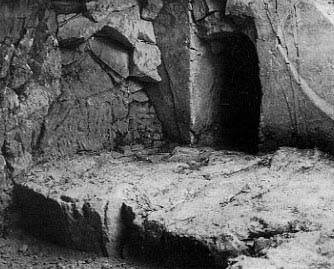

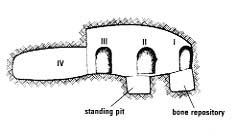
The ossuaries were decorated in typical patterns and motifs. The most common motif is the rosette, which appears in a variety of forms—sometimes with 12 petals, but more frequently with six petals, both encircled by a double ring. Another common motif is a zigzag pattern between rosettes and at the edge of the ossuaries.
Other typical decorations are of an architectural kind. A motif on one of our ossuaries is a fluted column, topped by a stylized Ionic capital and set on a stepped base, all in imitation of the entrance to monumental Jewish tombs that had a column built into the facade.3
Still another of our ossuaries integrates architectural and floral elements, a well-known combination from the period: A date palm with four fronds acting as a column is set on a stepped base of four steps. Above the date palm is a stylized Ionic capital, over which are additional geometric designs. This ornamentation reflects the source of the craftsman’s inspiration: mainly architectural monuments and the floral designs that originally accompanied these monuments.4
The lids of the ossuaries are sometimes flat, sometimes curved and sometimes gabled. In two ossuaries from this cave, we found marks on the narrow side of the ossuary and on the cover that were meant as guides to fit the lid on the box.5
The cave itself appears to be a burial place for a small family. But the relatively large number of ossuaries inside (12) suggests that this cave was used for a long time.
On five of the ossuaries were inscriptions—the names of the people whose bones had been placed inside. Some of the names were common in the period, like Miryam Berat Shim‘on, Miriam, daughter of Simon.
But the most exceptional and significant finds were the two ossuaries that, for the first time in an archaeological context, contained a form of the name Qafa’, or Caiaphas, a name known to us from both the New Testament and from the first-century Jewish historian Flavius Josephus. I will leave it to my colleague Ronny Reich to analyze these inscriptions in the accompanying article (“Caiaphas Name Inscribed on Bone Boxes”). Suffice it to say that the form(s) of the name Caiaphas inscribed on these ossuaries is probably the same as that of the well-known family of high priests, one of whom presided at Jesus’ trial.
Of the two ossuaries, one is inscribed simply “Qafa’” (ka-FA). On the other, the name is more complete: “Yehosef bar Qayafa’” (yeh-hoh-SEF bar ka-ya-FA), Joseph, son of Caiaphas, which is inscribed on the back of the long side of the ossuary, and “Yehosef bar Qafa’” Joseph, son of Caiaphas) on the narrow side.
The ossuary with the two more complete forms of the name is an especially beautiful one. It is decorated in a rare and intricate pattern of two circles, each containing six whorl rosettes6 divided into a center rosette with five rosettes encircling it.

There is no doubt that this ossuary is special. Its elaborate decoration must have something to do with the name(s) inscribed on it. Could this be the ossuary of the high priest who presided at Jesus’ trial?
Inside this ossuary, we found bones from six different people:7 two infants, a child between two and five, a young boy between 13 and 18, an adult woman—and a male of about 60 years! (The other ossuary with a Caiaphas inscription contained the bones of five individuals with an age and gender distribution very similar to the one just described—except for the absence of an elderly male!)
Incidentally, I should mention that, after anthropological study, the bones were given, as is customary, to the Ministry of Religious Affairs, which then reburied them on the Mount of Olives.
One other find has unusual significance, although unrelated to the name Caiaphas. In one of the other ossuaries—the one inscribed “Miriam, daughter of Simon”—a bronze coin of Herod Agrippa I dated to the year 42/43 C.E. was discovered in the skull of an adult woman.8 Burying the deceased with a coin placed in the mouth, as was originally the case here, is a pagan custom. The coin symbolizes a payment to the Greek god Charon for ferrying the deceased’s spirit across the River Styx. This custom was commonly associated with pagan burials, as for example in a Nabatean burial at Mampsis in the Negev.9 Now—for the first time—we find it as well in a Jewish burial in Jerusalem.
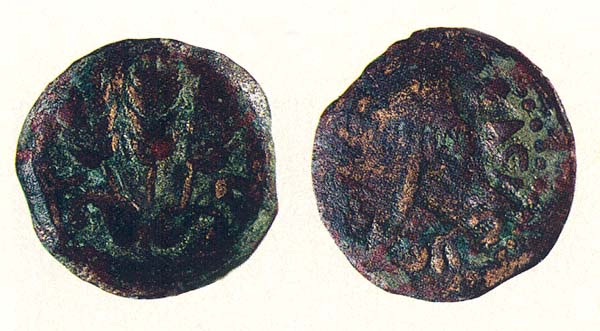
That this is not a complete anomaly in a Jewish burial is demonstrated by other examples excavated by Rachel Hachlili near Jericho.e In Jewish coffins (initial burials) at this site, Hachlili found several coins. In the skull of one woman was a coin minted by Herod Archelaus (4 B.C.E.–6 C.E.), son of Herod the Great. Two additional coins—minted by Herod Agrippa I (41–44 C.E.)—were discovered in a skull in a secondary burial. Hachlili initially interpreted these coins as having been placed on the eyes of the deceased. This gave rise to a heated debate in connection with the Shroud of Turin.
Subsequently, however, Hachlili concluded that the coins found in the skull had originally been put in the deceased’s mouth, not on the eyelids. The two coins “were found stuck together in the skull, which indicates that they had been placed together, that is, in the mouth, as opposed to separately, one over each eye.”10
The coin found in the skull from the Caiaphas burial cave is additional proof that in some Jewish burials from the Second Temple period, a coin was placed in the deceased’s mouth to assure passage across the River Styx. Coins placed elsewhere in the burial may have served the same purpose. In Greece, placing coins in the mouth was the custom, but in some cases the coin was placed in the deceased’s hand or elsewhere in the tomb.11
In some Jewish tombs, large sums have been found—many coins were found, for example, in the prominent Jerusalem burial monument known as the tomb of Jason12—apparently to provide for the deceased in the afterlife.13
In my opinion, the coin found in the burial in our cave unequivocally demonstrates a pagan Greek custom observed, though very rarely, by Jews in Jerusalem at this time. Furthermore, I believe we must now regard coins discovered in the context of Jewish tombs from the Second Temple period to be elements connected to the burial ceremony, despite the fact that they have not always been found in direct relation to the skulls or bodies of the deceased. It has recently been suggested that this pagan custom might have been confined to Jericho,14 but this argument is no longer tenable. The custom was also observed in Jerusalem.
This custom must be seen as part of a wide range of pagan influences on the Jewish population at this period. Likewise, the discovery of leather sandals in the tombs near Jericho15 indicate that they were a necessary accoutrement for the deceased’s last journey,” as was the Greek custom.16 The red color on part of the ossuaries, not only in our cave but elsewhere17 may symbolize the non-Jewish ritual of pouring blood on the bones of the deceased,18 or the equivalent to the “magic Greek custom of painting the inner sides of stone or clay sarcophagi.”19
Our burial cave also contained some common pottery, two small oil lamps and a small glass bottle. But a final discovery—two iron nails—deserves special mention: Apparently these were used to scratch the inscriptions on the ossuaries in the cave after the bones had been collected and placed in them and even after some of the ossuaries had been placed in their loculi. This is evident from the fact that some of the inscriptions were written perpendicularly, from the bottom to the top of the ossuary. But more of this in the following article by Ronny Reich.
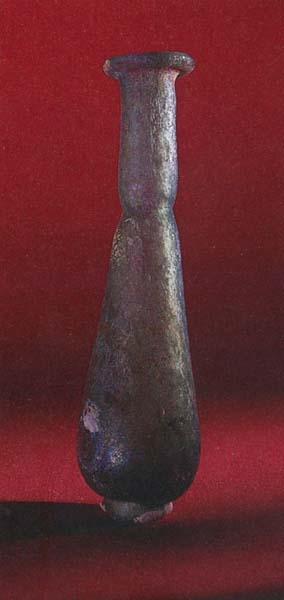
MLA Citation
Footnotes
B.C.E. (Before the Common Era) and C.E. (Common Era), used by this author, are the alternate designations corresponding to B.C. and A.D. often used in scholarly literature.
See “A New Generation of Israeli Archaeologists Comes of Age,” BAR 10:03.
Nahal is the Hebrew word for a dry river bed that flows occasionally in the winter rainy months; the Arabic is wadi.
Y. Shaked assisted both in the excavation and in the administration. The surveyor was A. Hajian. D. Weiss and G. Suleimani also participated. The first report of the excavation appeared in Zvi Greenhut, “Jerusalem—East Talpiot (Peace Forest),” Archaeological News 97 (1992), pp. 71–72 (in Hebrew). For the final report, see Greenhut, “The Caiaphas Tomb in North Talpiot, Jerusalem,” Atiqot 21 (1992).
See Rachel Hachlili, “Ancient Burial Customs Preserved in Jericho Hills,” BAR 05:04.
Endnotes
Amos Kloner, “The Necropolis of Jerusalem in the Second Temple Period,” dissertation, Hebrew Univ., 1980 (in Hebrew).
L.Y. Rahmani, “Ancient Jerusalem’s Funerary Customs and Tombs,” Biblical Archaeologist (BA) 45/2 (1982), pp. 109–119.
Ronny Reich and Hillel Geva, “Burial Caves on Mount Scopus,” Atiqot (Hebrew Series) 8 (1982), pp. 52–56.
Rahmani, “Jewish Rock Cut Tombs in Jerusalem, Atiqot (English Series) 3 (1961), pp. 107–108, fig. 7; Mishnah Shabbat 12:3.
Anthropological tests were performed by Joseph Zias and Tzipora Kahana of the Israel Antiquities Authority.
Avraham Negev, “The Nabatean Necropolis of Mampsis (Kurnab),” Israel Exploration Journal (IEJ) 21 (1971), p. 119.
Rachel Hachlili and Ann Killebrew, “Was the Coin-on-Eye Custom a Jewish Burial Practice in the Second Temple Period?” BA 46 (1983), pp. 147–153, esp. p. 150.
See J.M.C. Toynbee, Death and Burial in the Roman World (London: Thames & Hudson, 1971). These cases are also explained as representing the payment to Charon; cf. D.C. Kurtz and J. Boardman, Greek Burial Customs (London: Thames & Hudson, 1971).
Rahmani, “Some Remarks on R. Hachlili and A. Killebrew’s ‘Jewish Funerary Customs,’” Palestine Exploration Quarterly (PEQ) 118 (1986), pp. 96–100.
Hachlili and Killebrew, “Jewish Funerary Customs During the Second Temple Period, in the Light of the Excavations at the Jericho Necropolis,” PEQ 115 (1983), p. 128; Hachlili, “A Second Temple Period Jewish Necropolis in Jericho,” BA 43 (1980), p. 237.
Rahmani, “Jewish Rock Cut Tombs,” p. 103; Hachlili and Killebrew, “Jewish Funerary Customs,” p. 127.

